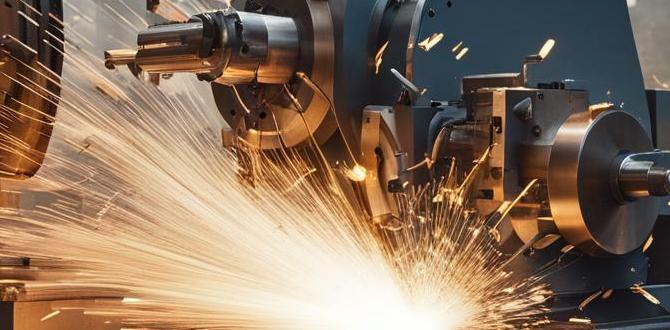A 1/8 inch carbide end mill can significantly reduce chatter when used correctly, especially with the right speeds, feeds, and setup. Choosing the right mill for your material, like cast iron, is key.
Have you heard that annoying ringing or scraping sound when milling? That’s chatter, and it can ruin your workpiece and damage your tools. For anyone using a milling machine, getting a smooth cut is super important. It makes your parts look better and fit together perfectly. The good news is, with the right tools and a few simple tricks, you can beat chatter. We’ll focus on the 1/8 inch carbide end mill, a small but mighty tool, and show you exactly how to use it for chatter-free results.
Understanding the Dreaded Chatter
Chatter, in the world of machining, is basically vibration. It happens when the cutting tool and the workpiece aren’t in sync. This causes the tool to repeatedly dig into and pull away from the material, creating a bumpy, noisy finish known as chatter marks. It’s frustrating because it makes your smooth surfaces look rough, can lead to poor dimensional accuracy, and wears out your cutting tools much faster. For beginners, chatter can be a real confidence killer. It feels like you’re doing something wrong, but often, it’s just a matter of understanding the forces at play and how to control them.
Why Small End Mills Can Be Tricky
A 1/8 inch end mill is a fantastic tool for detailed work, small parts, and getting into tight spaces. Its small diameter, however, means it has less rigidity than larger end mills. This makes it more susceptible to deflecting or vibrating. When you’re trying to get a clean cut with such a small tool, any tiny imbalance or incorrect cutting speed can easily turn into noticeable chatter. That’s why focusing on chatter reduction with this specific size is so important for achieving professional-looking results.
The Hero of Our Story: The 1/8 Inch Carbide End Mill
Carbide is a super hard material, much harder than high-speed steel (HSS). This hardness means carbide end mills can cut harder materials, maintain a sharper edge for longer, and operate at much higher cutting speeds. For a 1/8 inch end mill, carbide offers a significant advantage in rigidity and wear resistance compared to HSS of the same size. This makes it a go-to choice for hobbyists and professionals alike when precision and durability are needed.
What Makes a Carbide End Mill Good for Chatter Reduction?
Several features of a good 1/8 inch carbide end mill contribute to reducing chatter:
- Material Hardness: Its inherent hardness means it’s less likely to deform or vibrate under cutting forces.
- Sharp Edges: Carbide can be manufactured with extremely sharp and precise cutting edges, which slice through material rather than pushing, reducing vibration.
- Coating: Some specialized coatings can further reduce friction and heat, leading to smoother cutting.
- Flute Design: The number of flutes, helix angle, and web thickness all play a role in how the tool breaks chips and absorbs vibration.
Choosing the Right 1/8 Inch Carbide End Mill for Your Job
Not all 1/8 inch carbide end mills are created equal. To effectively reduce chatter, especially in materials like cast iron, you need to select the right type of mill for the task. Here are the key factors to consider:
Material Compatibility
Cast iron is a great material for many projects, but it can be abrasive and brittle. To mill cast iron effectively and minimize chatter, you’ll typically want:
- Uncoated Carbide: For cast iron, uncoated carbide is often preferred. Coatings can sometimes chip or wear away too quickly on abrasive materials, leading to poor surface finish and increased chatter.
- General Purpose or Cast Iron Specific: Many manufacturers offer end mills designed specifically for milling cast iron. These often have geometries optimized for chip evacuation and a smooth cutting action.
Flute Count Matters
The number of flutes on an end mill affects its cutting performance and chip-clearing ability. For 1/8 inch end mills:
- 2 Flutes: These are excellent for materials that tend to chip easily, like plastics and softer metals. They also offer more clearance for chip evacuation, which is beneficial for preventing chip recutting (another cause of chatter).
- 3 Flutes: A good compromise. They offer better surface finish than 2-flute mills and can typically handle higher feed rates. Often a good choice for general-purpose milling, including cast iron, if chip evacuation isn’t a major issue.
- 4 Flutes: Provide the best surface finish and are rigid. However, for smaller end mills like 1/8 inch, 4 flutes can struggle with chip evacuation in softer, “gummy” materials or materials that produce long, stringy chips. For cast iron, which produces granular chips, 4 flutes can work well if you have robust chip clearing.
For 1/8 inch carbide end mills and chatter reduction in cast iron, a 2-flute or 3-flute mill is often the sweet spot. The 2-flute offers superior chip evacuation, while the 3-flute provides a better balance of finish and feed rate if your machine can handle it.
Helix Angle
The helix angle refers to the spiral degree of the cutting edges. Common helix angles are:
- 30 degrees: A standard, versatile helix angle suitable for many materials.
- 45 degrees: Offers a steeper cut, which can lead to a smoother finish and reduced chatter in some materials.
- High Helix (>45 degrees): These aggressively shear the material, providing excellent chip evacuation and a very smooth finish. They are particularly good for softer materials and can be excellent for reducing chatter.
For cast iron and chatter reduction, a medium-to-high helix angle (30-45 degrees or more) can be beneficial. It allows the cutting edge to engage the material more gradually, reducing impact and vibration.
Shank Diameter and Length
While we’re focusing on a 1/8 inch cutting diameter, the overall shank size and length are also critical for preventing chatter. A 1/8 inch end mill with a plain 1/8 inch shank is very prone to vibration. For better rigidity and chatter reduction, it’s highly recommended to use:
- 1/4 inch or 1/2 inch shank: Wherever possible, use a 1/8 inch end mill that has an adapter or is manufactured with a larger shank (e.g., a 1/8″ cutting diameter with a 1/4″ shank, or a 1/8″ cutting diameter held in a 1/4″ or 1/2″ collet). A larger shank provides more mass and stiffness, significantly reducing the tendency to vibrate.
- Standard Length: Shorter tools are generally more rigid than longer ones. For a 1/8 inch end mill, opt for a standard or “stub” length to maximize rigidity and minimize the chance of chatter caused by tool deflection.
Mastering the Cutting Parameters: Speeds and Feeds for Chatter-Free Milling
This is where the magic happens. Even with the best end mill, incorrect speeds and feeds will invite chatter. Getting these right is crucial for any milling operation, but especially for small tools.
Understanding Surface Speed (SFM) and RPM
Surface speed, measured in surface feet per minute (SFM) or meters per minute (m/min), is the speed at which the cutting edge of the tool is moving through the material. Your machine’s spindle speed (RPM – Revolutions Per Minute) is what you set, but it translates into SFM based on the diameter of the cutting tool.
The formula to calculate RPM is:
RPM = (SFM 3.82) / Diameter (in inches)
Or, in metric:
RPM = (Surface Speed (m/min) 1000) / (π Diameter (mm))
Why is this important for chatter?
- Too fast: High RPMs can cause the tool to chatter as it “bounces” across the material, leading to rapid tool wear and poor finish.
- Too slow: Very low RPMs can engage too much material at once, causing the tool to rub and vibrate, again leading to chatter.
For 1/8 inch carbide end mills in cast iron, a good starting point for surface speed is often in the range of 200-400 SFM, depending on the specific alloy of cast iron and the end mill geometry. Let’s calculate an example:
If you want to run at 300 SFM with your 1/8 inch (0.125 inch) carbide end mill:
RPM = (300 SFM 3.82) / 0.125 inches = 9168 RPM
Consulting feed and speed charts is highly recommended. Many tool manufacturers provide these, as do online calculators. For example, Iscar’s website offers a useful tool selection and feeds/speeds calculator.
Feed Rate: The Key to Smooth Cutting
The feed rate is how fast the tool moves through the material per revolution (or per minute). It’s often expressed in inches per minute (IPM) or millimeters per minute (mm/min). For small end mills, it’s common to talk about chip load.
Chip Load
Chip load is the thickness of the material removed by each cutting edge (or tooth) of the end mill with each revolution. It’s crucial for chatter reduction.
The formula for chip load is:
Chip Load = Feed Rate (IPM) / RPM
And conversely:
Feed Rate (IPM) = Chip Load RPM Number of Flutes
Why is chip load so important for chatter?
- Too light (tiny chips): When the chip load is too small, the cutting edge effectively rubs against the material rather than cutting it cleanly. This rubbing action creates friction and vibration, leading to chatter. Imagine trying to shave with a dull knife versus a sharp one – same principle!
- Too heavy (huge chips): If the chip load is too high, the tool might not be able to clear the chips properly, or it could overload the cutting edge, leading to tool breakage or severe chatter as the tool struggles to penetrate.
For a 1/8 inch carbide end mill in cast iron, a typical chip load might range from 0.001 to 0.003 inches per tooth. Let’s use our calculated RPM of 9168:
- If Chip Load per tooth is 0.002 inches, and we use a 2-flute end mill:
Feed Rate = 0.002 inches/tooth 9168 RPM 2 flutes = 36.67 IPM- If Chip Load per tooth is 0.002 inches, and we use a 3-flute end mill:
Feed Rate = 0.002 inches/tooth 9168 RPM 3 flutes = 55.01 IPM
These calculated numbers are starting points. You’ll always want to experiment slightly to find the sweet spot for your specific machine and setup.
Depth of Cut and Width of Cut
These parameters determine how much material the end mill removes in a single pass.
- Depth of Cut (DOC): How deep the tool cuts into the material vertically.
- Width of Cut (WOC): How wide the engagement of the tool is horizontally. For a 1/8 inch end mill, you’re usually dealing with slots or pockets.
With small end mills, ‘chipload’ is often determined by the axial depth of cut and the radial width of cut. For chatter reduction, especially when milling slots or pockets (where WOC can be close to the tool diameter), it’s often beneficial to:
- Take lighter axial depths of cut: Don’t try to hog out material. Multiple shallow passes are better than one deep pass.
- Use a smaller radial width of cut: When milling a slot, try not to mill the full 1/8 inch width in one pass if possible. Step over (radial cut) by less than 50% of the diameter.
- Consider High-Efficiency Machining (HEM) or Dynamic Milling: These strategies use a small step-over (radial WOC) and a large axial depth of cut, while maintaining a relatively constant chip load and tool engagement. This can lead to very smooth cuts and less chatter because the tool is always engaged in a controlled way, and heat is distributed across many teeth. This is advanced, but the principle of light radial engagement is key.
Crucial Setup Steps for Zero Chatter
A perfect end mill and perfect speeds/feeds won’t help if your setup is shaky. Rigidity is king!
Tool Holding: The Foundation of a Stable Cut
How you hold the end mill in your machine is arguably the most critical factor in preventing chatter, especially with small tools.
- Collet Chucks are Superior: For 1/8 inch end mills, using a high-quality collet chuck (like a CAT, BT, or Weldon shank with a precision collet) is highly recommended over a standard drill chuck. Collets provide much truer runout and a more secure grip, leading to a more stable cut.
- Proper Collet Size: Always use the collet that is the closest fit to your end mill shank. If you have a 1/8 inch shank, use a 1/8 inch collet. If you are using a 1/8 inch end mill with a 1/4 inch shank in a collet chuck, use a 1/4 inch collet. Avoid using adapter sleeves that reduce the shank too much, as these can introduce runout and flexibility.
- Cleanliness is Key: Ensure the collet, the collet chuck, and the end mill shank are absolutely clean and free of coolant, oil, and debris. Any foreign matter can prevent the collet from gripping the tool evenly, leading to runout and vibration.
- Avoid Drill Chucks for Milling: While convenient, drill chucks are designed for drill bits and typically have more runout and less rigidity than collets, making them a common source of chatter when milling.
Workpiece Holding: Rock Solid is Best
Your workpiece needs to be held down firmly. Any movement or vibration of the workpiece will be transmitted to the cutting tool, exacerbating chatter.
- Use Clamps or Vises Securely: Ensure your workpiece is held in a robust vise or with sturdy clamps. Avoid using any setups that allow the workpiece to flex or move under the cutting forces.
- Consider Fixturing: For repetitive parts or when maximum rigidity is needed, a custom fixture can be made to hold the workpiece immovably.
- Clean Contact Surfaces: Make sure the surfaces between your workpiece, your vise/clamps, and your machine table are clean and free of debris. This ensures maximum contact and minimum slippage.
Machine Rigidity and Maintenance
Your milling machine itself needs to be in good condition.
- Check Gibs: Ensure the gibs on your machine’s ways are properly adjusted. Loose gibs allow play in the slides, which directly translates into vibration and chatter.
- Spindle Taper Cleanliness: Just like with collets, ensure the spindle taper is spotless. Any dirt or damage here will impact tool runout.
- No Backlash: While some backlash is normal in older machines, excessive backlash in the lead screws can cause chatter.
For a comprehensive guide on machine maintenance and setup, resources like AMT’s Manufacturing Basics provide excellent foundational knowledge.
Troubleshooting Chatter with a 1/8 Inch End Mill
Even with the best practices, you might still encounter chatter. Here’s how to diagnose and fix it:
| Symptom | Possible Cause | Solution |
|---|---|---|
| High-pitched ringing noise, rough finish (most common) | Tool deflection, incorrect RPM or feed rate, light chip load |
|





